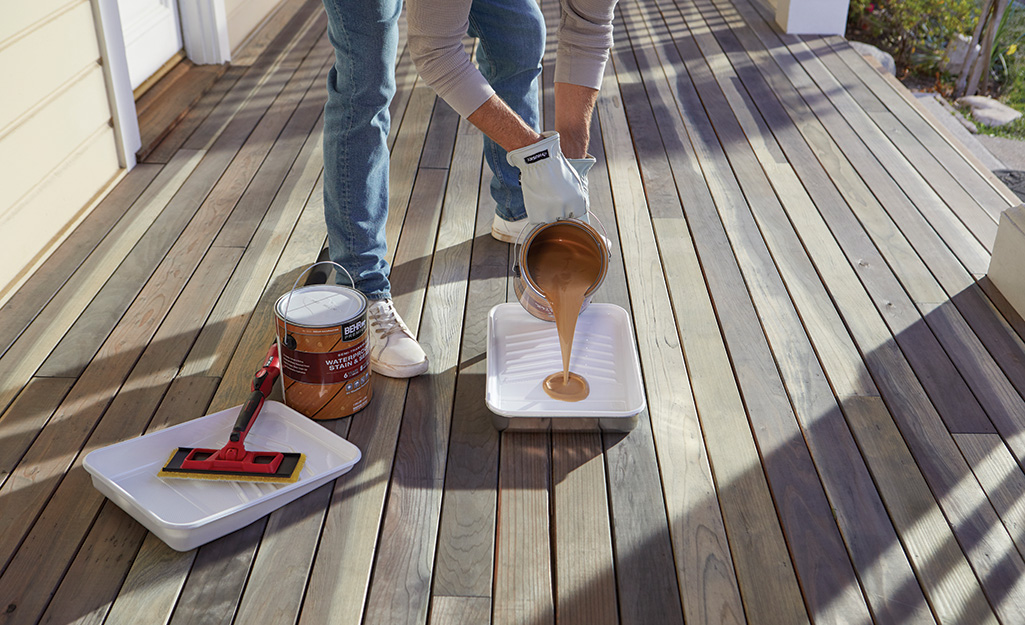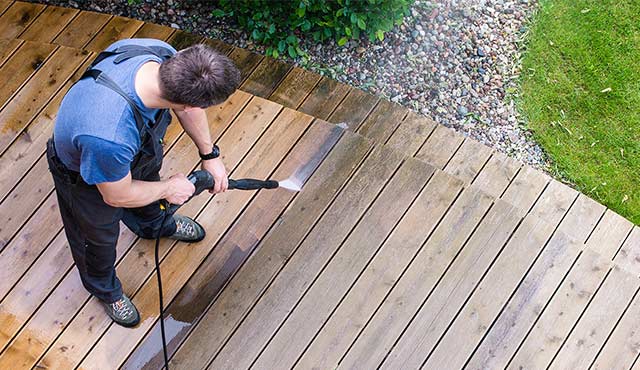A Comprehensive Guide to Various Kinds Of Deck Staining Techniques for Ultimate Protection and Aesthetic Appeals
In the realm of deck upkeep, the art of staining stands as a crucial action towards both protecting the integrity of your exterior area and boosting its visual allure. As we navigate via the complex world of deck staining strategies, one begins to value the nuanced methods that can make all the distinction between a sub-par surface and a remarkable one.
Comprehending Various Types of Discolorations
Various kinds of stains are frequently used in the process of deck discoloration to achieve different visual and protective impacts. Clear stains are suitable for showcasing the natural grain of the wood while giving minimal security versus UV rays and moisture. On the other hand, semi-transparent discolorations offer a balance in between shade enhancement and security, permitting some wood grain to show with. For an extra opaque finish that supplies optimum defense against the aspects, strong discolorations are the recommended choice. These discolorations can be found in a large array of colors and efficiently hide the timber grain.
Toners include a tip of color to the wood while providing marginal defense, making them appropriate for newer decks with much less wear. Recognizing the attributes and benefits of each kind of discolor is important for achieving the wanted appearance and sturdiness for your deck.
Choosing the Right Discoloration Shade
When considering the visual appeals of your deck discoloration job, the choice of tarnish color plays an essential role in improving the protective top qualities of the chosen tarnish type (Water-Based Stains). The color you pick can considerably influence the general appearance of your deck, in addition to its ability to stand up to the elements with time
When selecting a tarnish color, it's crucial to think about the existing shade scheme of your home's outside. Harmonizing the deck discolor with the total aesthetic of your property can produce a natural and visually attractive exterior space. Furthermore, the color of your deck tarnish can influence the temperature level of the deck surface area; darker colors have a tendency to soak up more warm, while lighter shades mirror sunlight and stay cooler.
In addition, the kind of wood you are discoloring will certainly also affect exactly how the tarnish shade shows up. Different wood types can connect with the tarnish in various methods, possibly modifying the last shade. It's advisable to check the discolor on a small, inconspicuous location of the deck to guarantee the shade ends up as wanted prior to proceeding with the entire project.
Preparing Your Deck for Staining
To ensure a resilient and successful deck staining task, detailed prep work of the deck surface area is vital. Begin by cleaning up the deck thoroughly to get rid of dust, gunk, mildew, and any kind of old finish or tarnish.
Check the deck for any type of damaged or rotten boards that require to be replaced. Hammer down any sticking out nails and sand any type of rough locations to make sure a smooth surface for discoloration. Look for any loosened railings or actions that might need tightening up or repair work.
Once the deck is tidy, completely dry, and in great fixing, think about using a wood brightener to recover the deck's natural color and open the wood pores for much better tarnish penetration. Protect any type of neighboring plants, furniture, or surfaces with plastic sheet prior to proceeding with the staining procedure. Correct preparation is essential to accomplishing a professional-looking coating and taking full advantage of the long life of your deck stain.
Applying Spot With Different Strategies
For a expert and perfect coating, the approach of applying stain plays a vital function in improving the look and resilience of your deck. There are several techniques you can use to make sure a reliable application of tarnish.
Brushing is a conventional method that permits precision and control over the amount of discolor applied. It is optimal for complex locations and getting to in between deck boards (Chicago Deck Staining). Rolling is a quicker alternative, covering bigger surface successfully. Back-brushing after rolling is recommended to also out the tarnish and function it into the wood for better penetration.
Spraying is another popular strategy, using speed and ease of application, especially for huge deck areas. It is essential to use a high-quality sprayer and be conscious of overspray. Pad applicators supply a smooth and even end up and appropriate for both upright and horizontal surface areas. Whichever method you choose, making certain appropriate preparation and adhering to maker guidelines will certainly assist achieve a lovely and lasting discolor coating on your deck.

Keeping and Re-staining Your Deck
When it comes to re-staining your deck, the frequency Chicago Deck Staining depends on different aspects such as the type of discolor used, the environment in your location, and exactly how much wear and tear your deck experiences. Usually, it is suggested to re-stain your deck every 2-4 years to maintain its defense and appearances.
Before re-staining, make certain the deck is clean, dry, and devoid of any type of previous discolor deposit. Fining sand may be required to smooth out harsh locations or get rid of old stain that is flaking. Pick a premium stain that fits your deck's product and gives the desired level of security. Apply the tarnish equally utilizing the ideal technique gone over previously in this overview to make sure a lovely and durable finish - Water-Based Stains. By remaining proactive with maintenance and re-staining, you can appreciate a well-protected and aesthetically appealing deck for several years to find.
Verdict
Finally, understanding the different types of deck spots, selecting the best color, correctly preparing the deck, using discolor with various strategies, and re-staining the deck and preserving are essential steps for best defense and appearances. By complying with these actions, you can make sure that your deck continues to be in top condition for several years to come.
Furthermore, the color of your deck stain can affect the temperature level of the deck surface area; darker colors often tend to take in more warmth, while lighter shades mirror sunshine and stay cooler.
It's recommended to test the tarnish on a little, inconspicuous location of the deck to make sure the color transforms out as preferred prior to continuing with the entire job.
